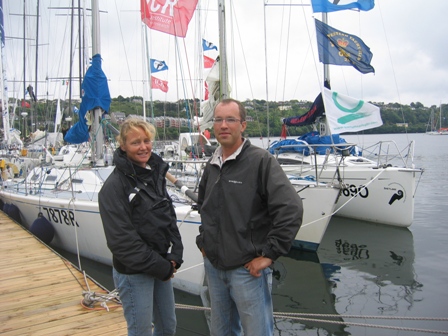Pip Hare fights for her lead and admires the marine life in the Shetland Round Britain & Ireland Race
58° 05.71N
8° 05.76W
Course 050° Speed 7.2 knots
We are just under a day into leg 3 of the Shetland Round Britain & Ireand Race and on The Shed Phil and I have managed to work a considerable lead over the next boat in our class.
And we are going to need it.
Despite my worries, we did have wind at the restart for this leg. We made our way out to the line, the last to start of a group of three boats, and managed to welcome ‘Kipper’, the Victoria 34 in class 4, across the finish line.
All my hopes were that we would have wind to the end of the island chain, which would help us to keep the lead we had gained so far, and lucky enough we got what we wanted.
We sailed with spinnaker to Barra Head, the light was fading and there was a stunning sun set with streaks of pink, blue and grey cloud over the top of the islands as the sun set, though it never really got dark.
We are now a long way north, further north in fact than Cape Horn is south, and I do not think we will see darkness during the night for perhaps another week, when we start to drop latitude on the other side of British isles.
The light was beautiful but a little eerie and to add to the effect the water seems to be full of basking sharks, so quite often you will look up to see a dorsal fin cutting its way through the grey light around you then retreating menacingly back to the depths.
Once we had made it around the bottom of the Barra Island chain, our next stop was St Kilda, a large lump of rock out to the west.
As the forecast said, the wind shut off completely just after midnight but as we had made it around the islands we were able to ride the north flowing tide, up the other side and closer to the new breeze as it filled in.
By 4am we were sailing again and due to the good luck of being in a favourable tide had managed to double our lead on the boats behind us, which were still struggling in unfavourable tide and no wind. This will be important as we have now rounded St Kilda and the next leg of our race is a 280-mile downwind spinnaker run in moderate airs. Our worst nightmare!
The Shed, an Oyster Lightwave 395, is a reasonably heavy displacement boat which needs a good 20 knots of wind to get her going downwind. The pack behind us are more modern and lighter and so we imagine will surf quicker and faster in the conditions we have at the moment.
That is why extending our lead at the start of this race has been so important. We just have to sail like mad things and hope they do not eat too much of it away before we have to turn the corner at the Shetland Islands.
Rounding St Kilda was a strange experience. A front was passing over us and the island was shrouded in a thick mist. We could only see the bottom half of it from half a mile away.
I do not have detailed charts for right up close to the shore so both Phil and I were a little jumpy as to just how close we could get, torn between giving away valuable distance and the fear of ending up on an uncharted spiky rock should we get too close.
It was like a scene from Jurassic park. The island is barren and jagged, the mist was rolling around the tops of the rocks and you could not see how high or wide the land mass was. I was expecting to feel the vibrations of a Tyrannosaurus footstep and a roar in the background as we passed close by.
Once clear of the island we have really entered the open sea.
As mentioned it is 280 miles to the top of Shetland, but not so straight forward as just sailing there.
The weather at the moment has been dominated by a ridge of high pressure and various skippers will have various theories on how to get the most from their boats, where the wind will be strongest, which angles it is better to sail, and whether sailing the angles with more speed will be faster than a straight line, slow but shorter distance.
I think all eyes from behind us will be on our tracker, watching to see which way we have gone, and equally we must keep an eye on them. If any of our competitors decide to sail in a different direction from us we must evaluate, what they are doing and whether we can afford to allow them to split or if we must cover them by copying their strategy.
Brains are straining and the trackers have become a vital piece of tactical equipment. We are keeping our cards up our sleeves. This race has become about the thinking as well as the sailing; I am playing my cards close. Let’s see how we look in the morning.
However for any of our class who are reading this and looking for some inside information, here we go:
We have decided it will be a lot quicker to go via the Faroes!




